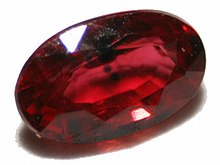The topic of this article may not meet Wikipedia's general notability guideline .(December 2023) |
| Ruby | |
|---|---|
 A natural ruby | |
| | |
| Hex triplet | #E0115F |
| sRGB B (r, g, b) | (224, 17, 95) |
| HSV (h, s, v) | (337°, 92%, 88%) |
| CIELChuv (L, C, h) | (48, 130, 1°) |
| Source | Maerz and Paul [1] |
| ISCC–NBS descriptor | Vivid red |
| B: Normalized to [0–255] (byte) | |
Ruby is a color that is a representation of the color of the cut and polished ruby gemstone and is a shade of red or pink.
